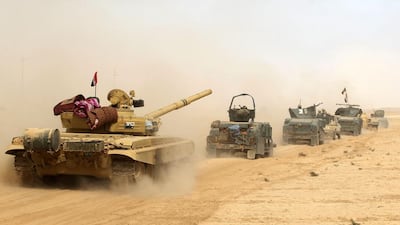KHAZER // As the sun rose on Monday, thousands of fighters climbed into their vehicles and drove off into the climactic battle of a two-year war to rid Iraq of ISIL.
Iraqi troops and Kurdish peshmerga advanced on Mosul on three fronts, rolling across the dusty flats of the Nineveh plains on both sides of the Tigris.
On the south bank of the river, the Iraqi army advanced from Qayyarah, one of the main staging points of the operation where the US military is providing logistical support from the nearby airbase. North of the river, the Iraqi army thrust forward from the town of Gwer, while a little further to the north still the peshmerga pushed from Khazer, a front where the Kurds have made repeated gains over the summer.
Iraqi prime minister Haider Al Abadi appeared on television in the early morning to announce the start of the operation to liberate Mosul, which fell to ISIL in June 2014.
“The hour of victory has come, the operation to liberate Mosul has started. God willing, we will meet in Mosul to celebrate the liberation and your salvation from Daesh so we can live together once again, all religions united and together,” Mr Al Abadi declared, wearing the black uniform of Iraq’s Golden Division, the special forces that are expected to spearhead the advance into the city.
Shortly afterwards, coalition jets and helicopters began to target ISIL defences, unleashing rockets, bombs and cannonfire on the insurgents, directed by special forces on the ground.
Attacking with overwhelming force across open ground, both the army and the peshmerga made good progress, and succeeded in taking a string of villages during the course of the day. But the dash across the flat land was not without peril, as ISIL deployed its usual tactic of sending suicide car bombs to slow the advance.
By afternoon, the old Kurdish front line at Khazer – a berm and a trench stretching across the arid farmland – had been punctuated by advance routes to villages lining the horizon. Less than 20 kilometres behind the villages lay Mosul. Smoke rose into the sky in the distance, black plumes from the tyres set alight by ISIL to obscure the vision of coalition aircraft preying above, white clouds marking suicide vehicles destroyed from the air or by peshmerga anti-tank missiles.
Groups of peshmerga had taken up position on the wayside, fighters resting in the shade of their pickup lorries while bulldozers were busy shovelling earthen fortifications to secure the flank of the attack. The Kurdish line of attack is aimed at Qaraqosh, a Christian town whose inhabitants fled the ISIL onslaught in 2014.
Once Qaraqosh is secured, ISIL’s defences will be pierced at further points on the Kurdish front line to the north of Mosul, while the Iraqi army continues to reduce the territory standing between its advance columns and Mosul. The fight for Mosul itself will be led by the Golden Division, which has defeated ISIL in a number of cities, most recently retaking Fallujah in May.
With the extremists’ large major stronghold in Iraq facing attack, observers have warned that ISIL may seek to attack civilians in Baghdad and elsewhere.
A suicide car bomb attack claimed by the group killed at least 10 people on Monday in Yusufiya, just south of the capital. The blast, which targeted an army checkpoint, also wounded 17.
Several thousand ISIL fighters are expected to remain in Mosul. With ample time to prepare their defences, the extremist militants are not going to be easy to dislodge. An elaborate network of tunnels, extensive mining of the city, and trenches and concrete barriers will make the going tough. ISIL will also use Mosul’s civilians as human shields, reducing the effectiveness of coalition air support.
Ahead of the Mosul operation, Iraqi army spokesman Colonel Faris Sabri suggested that Iraqi forces would leave a corridor for the militants to leave the city to try to avoid heavy civilian casualties from street fighting.
"It is possible. In war you have to be flexible to win," he told The National in response to the question of whether a corridor will be left open via the town of Tel Afar near the Syrian border.
If the city’s remaining inhabitants – who are thought to number more than 1 million – attempt to flee the fighting, they will quickly overburden the capacity of aid agencies to cater for the displaced. The absence of clearly communicated escape routes will make the journey out a dangerous one, NGOs warn.
“Civilians who attempt to escape the city will have little choice but to take their lives into their own hands and pray that they are able to avoid snipers, landmines, booby traps and other explosives,” said Aleksandar Milutinovic, the International Rescue Committee’s Iraq county director.
foreign.desk@thenational.ae

